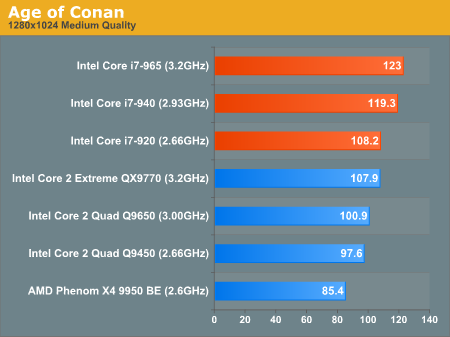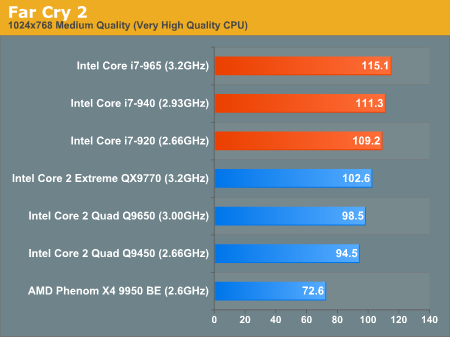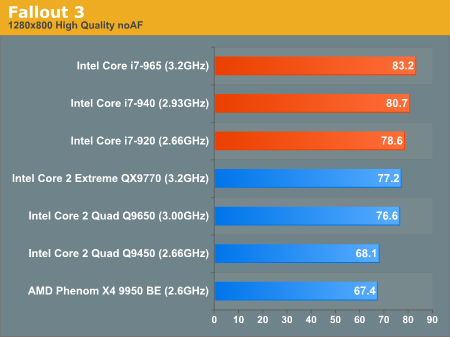The Dark Knight: Intel's Core i7
by Anand Lal Shimpi & Gary Key on November 3, 2008 12:00 AM EST- Posted in
- CPUs
Gaming Performance
We have already teased you with the results of our gaming benchmarks, but sometimes charts are easier to look at than tables. I should stress that to get any of these modern games to be even remotely CPU bound I had to drop resolution and image quality, which is fine for this as we're trying to evaluate whether or not Nehalem is architecturally faster. In the real world however, you'll not see any performance difference in any of these titles with Nehalem over Penryn.
We start off with our Age of Conan benchmark. This is a fraps test, we take our character and swim him to shore and back measuring performance during the process.
Note that to get this game to be at all CPU bound we had to drop to medium quality and run at 1280 x 1024:

This is the only game where we see Nehalem boast such a tremendous performance advantage. I suspect that it's extremely sensitive to memory latency for some reason, resulting in the i7-920 being faster than the QX9770.
Our GRID benchmark is a fraps test that measures frame rate at the very beginning of a race with our car starting at the back and then crashing into a wall:

While racing games are usually great physics tests, GRID just wasn't CPU bound enough to show serious differences between the CPUs. Nehalem and Penryn are basically no different here.
For Crysis we ran the built in CPU2 benchmark on version 1.21 of the game:

Like GRID, Nehalem offers nothing over Penryn in the performance department.
Far Cry 2's built in benchmark tool using the Ranch small test brings us our next set of numbers:

Here we have another game that favors the Core i7's architecture, but as we just saw it's not an across the board sort of win as some games miss Penryn's larger L2 cache.
Our last benchmark is a walk towards Megaton in Fallout 3:

The edge goes to Intel's Core i7 once again.
Overall in gaming tests the situations where Nehalem was faster than Penryn outnumbered those where it didn't, but upgrading to Nehalem for faster gaming performance doesn't make sense. We were entirely too GPU bound in all of these titles, if you want Nehalem it should be because of its performance elsewhere.










73 Comments
View All Comments
npp - Tuesday, November 4, 2008 - link
Well, the funny thing is THG got it all messed up, again - they posted a large "CRIPPLED OVERCKLOCKING" article yesterday, and today I saw a kind of apology from them - they seem to have overlooked a simple BIOS switch that prevents the load through the CPU from rising above 100A. Having a month to prepare the launch article, they didn't even bother to tweak the BIOS a bit. That's why I'm not taking their articles seriously, not because they are biased towards Intel ot AMD - they are simply not up to the standars (especially those here @anandtech).gvaley - Tuesday, November 4, 2008 - link
Now give us those 64-bit benchmarks. We already knew that Core i7 will be faster than Core 2, we even knew how much faster.Now, it was expected that 64-bit performance will be better on Core i7 that on Core 2. Is that true? Draw a parallel between the following:
Performance jump from 32- to 64-bit on Core 2
vs.
Performance jump from 32- to 64-bit on Core i7
vs.
Performance jump from 32- to 64-bit on Phenom
badboy4dee - Tuesday, November 4, 2008 - link
and what's those numbers on the charts there? Are they frames per second? high is better then if thats what they are. Charts need more detail or explanation to them dude!TSM
MarchTheMonth - Tuesday, November 4, 2008 - link
I don't believe I saw this anywhere else, but the spots for the cooler on the Mobo, they the same as like the LGA 775, i.e. can we use (non-Intel) coolers that exist now for the new socket?marc1000 - Tuesday, November 4, 2008 - link
no, the new socket is different. the holes are 80mm far from each other, on socket 775 it was 72mm away.Agitated - Tuesday, November 4, 2008 - link
Any info on whether these parts provide an improvement on virtualized workloads or maybe what the various vm companies have planned for optimizing their current software for nehalem?yyrkoon - Tuesday, November 4, 2008 - link
Either I am not reading things correctly, or the 130W TDP does not look promising for the end user such as myself that requires/wants a low powered high performance CPU.The future in my book is using less power, not more, and Intel does not right now seem to be going in this direction. To top things off, the performance increase does not seem to be enough to justify this power increase.
Being completely off grid(100% solar / wind power), there seem to be very few options . . . I would like to see this change. Right now as it stands, sticking with the older architecture seems to make more sense.
3DoubleD - Tuesday, November 4, 2008 - link
130W TDP isn't much worse for previous generations of quad core processors which were ~100W TDP. Also, TDP isn't a measure of power usage, but of the required thermal dissipation of a system to maintain an operating temperature below an set value (eg. Tjmax). So if Tjmax is lower for i7 processors than it is for past quad cores, it may use the same amount of power, but have a higher TDP requirement. The article indicates that power draw has increased, but usually with a large increase in performance. Page 9 of the article has determined that this chip has a greater performance/watt than its predecessors by a significant margin.If you are looking for something that is extremely low power, you shouldn't be looking at a quad core processor. Go buy a laptop (or an EeePC-type laptop with an Atom processor). Intel has kept true to its promise of 2% performance increase for every 1% power increase (eg. a higher performance per watt value).
Also, you would probably save more power overall if you just hibernate your computer when you aren't using it.
Comdrpopnfresh - Monday, November 3, 2008 - link
Do differing cores have access to another's L2? Is it directly, through QPI, or through L3?Also, is the L2 inclusive in the L3; does the L3 contain the L2 data?
xipo - Monday, November 3, 2008 - link
I know games are not the strong area of nehalem, but there are 2 games i'd like to see tested. Unreal T. 3 and Half Life 2 E2.. just to know how does nehalem handles those 2 engines ;D